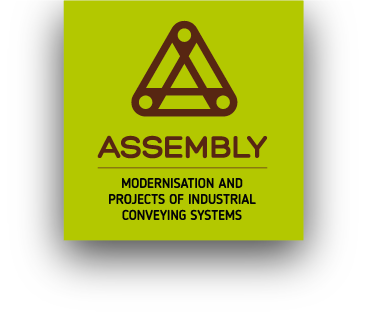Increasing productivity in your manufacturing plan, reducing accidents and product breaks or damage, saving energy. All these benefits are possible by installing or modernising conveyor systems in your own plant. In this article, you will find some advice and types of conveyor systems.
Conveyor systems and their benefits
A conveyor system is an essential component in any manufacturing plant. Conveyor systems allow for automatised and efficient movement of materials and products, which otherwise would have to be conveyed by hand or by medium duty elements that can only work when handled by a human (e.g. fork lifts).
When a conveyor system is installed, accidents decrease, as it is less likely that workers get injured by moving products or heavy loads; consequently, product breaks and damage are also fewer; and, in general, plants become more productive, as fewer workers are required to carry out the same action.
The same goes for old conveyor systems that are modernised or replaced by new ones. Using motors and active elements with a higher energetic efficiency, adapting the speeds and line capacities to the real flow of products, handling the product as gently as possible, adding elements that increase personal safety or others that permit to measure and control product flow in detail, all of them are possible measures to increase productivity and save energy in the facilities.
Basic aspects when choosing your conveyor system
A number of factors must be considered when choosing the type of conveyor system. The size and weight of the materials or products to be conveyed, the distance to cover, the movement design and its peculiarities -height, turns-, how gently some products must be handled, the necessary flow of materials, the safety measures for people or the traceability of the system are just some of the aspects to take into account.
Some common types of conveyor systems
Medium duty conveyors
Very much used in the food industry in the form of modular conveyors, with belts allowing for making curves, adaptability to processes and products, very simple maintenance and replacements. It is common practice in this industry for frames to be made in stainless steel, aluminium profiles and that the rest of components be non-poisonous and meet the FDA standards.

It is a very large field, also applicable to many other industries, where we can adapt conveyors whose belt lays on a plate bed (usually PVC), together with 45º or 90º curve angles, powered roller conveyors with step chains and rollers with double pinion, roller curves, etc.
Landscape conveyors
For long distance conveyance, landscape conveyors can help reach long distances and adapt to the topographic line of the land, even to curved angles on the horizontal plan. For example, conveyors charging at A and discharging at B, linking two machines of independent processes or just receiving finished product and delivering it at the stock area.
Trippers can be installed all along these landscape conveyors, as long as they are horizontal. The trippers discharge the product at one or both ends of the main conveyor, transferring the product to stock piles or to other conveyors located at both ends of the main one.

Reversible belt conveyors
Conveyors whose length is not especially relevant, and where products can be discharged at both ends. Depending on the length, these conveyors are motorised at both ends, in both drive pulleys, which allows for a drive head to push and the other, as usual, pull the belt.
These reversible conveyor belts very often include transfer movement, which allows multi-discharge, for instance in batteries of deposits, or have the option of receiving product at several positions, by installing shock-absorbing roller frames at each transfer area.
Radial curve, telescopic and variable incline conveyors
Kidney-shaped, pivoting product stockpile conveyors at the product reception area. They usually allow for variable incline, by means of cylinders for big loads, so that the discharge height does not scatter the product when dealing with different granulometries.
In big systems, there are telescopic discharge systems, which extend the length of the main conveyor, thus allowing for much bigger stock volumes. In general, these telescopic systems are remote controlled and full conveyors are moved by means of boogies with pneumatic wheels or systems of metallic worms, depending on the weight of the equipment and the ground in which it has to be moved.
Belt or metallic discharge chutes
Conveyors of reduced lengths, low speeds and reducers calculated for high torques, all this aimed at discharging materials in deposits, hoppers, etc. If the product has small granulometries and its edges are not big, then rubber belts adapted to the characteristics of the product are used. In the case of big edges and/or big granulometries, belts are replaced by metallic sheets guided by wing chains.
Discharge chutes are usually equipped with weighing equipment, so that product dosage is controlled and that they can be installed in series for blending systems in a number of industries (e.g. arid sands, fertilisers, chemical or farming industry).


